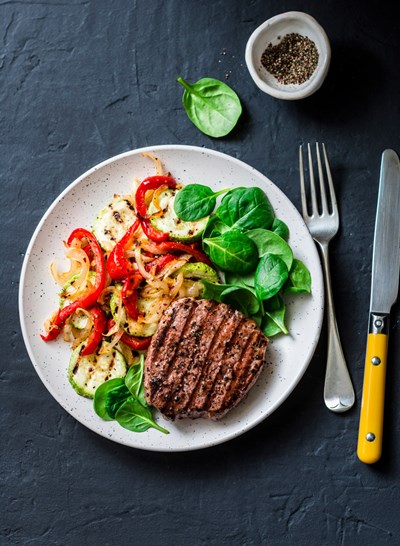
In Defense of Carbs: Why They Can Still Work for Your Eating Plan
Good news carb-lovers – dietitians agree this macronutrient can still be included in your daily diet, even if you’re cutting down on carbohydrates in order to go keto to test out a low-carb lifestyle.
The key is to focus on the quality of your carb sources.
“Carbohydrates should primarily consist of non-starchy veggies like leafy greens, cucumbers, broccoli, cauliflower, etc., as these consist mostly of fiber along with important vitamins and minerals,” says Lianne Stephanos, a registered dietitian with the Hawaii Pacific Health 360º Weight Management Center at Pali Momi Medical Center.
Depending on how low your carbohydrate recommendation is, there may still be room for some complex carbohydrates like berries, high-fiber whole-grain wraps and breads, starchy vegetables and dairy, such as plain Greek yogurt.
“Complex carbohydrates are always the recommended choice, as these are minimally processed, higher in fiber and maintain their nutritional integrity, which in turn has less of an impact on our blood sugar and insulin response,” Stephanos explains.
In Defense of Carbs
Just as fat was vilified in the ’80 and ‘90s as the cause of health problems and expanding waistlines, carbs have come under crossfire in recent years for similar reasons.
To clear up any confusion, all food is made up of some combination of three macronutrients – carbohydrates, proteins and fats.
Each macronutrient plays a role in how our bodies work.
The main function of carbohydrates is to provide energy via the breakdown of glucose. They also help with digestion from fiber, which also is beneficial for heart health and diabetes.
However, the body has the ability to carry out these important functions without carbs.
“Carbohydrates are the only macronutrient group that is nonessential,” Stephanos says. “We don’t physically have to eat carbohydrates to survive – our bodies can produce the energy it needs to survive by switching from using glucose as its energy source to using fat and ketones as its energy source. This process also is known as ketosis.”
Stephanos adds that research has shown that the production of ketones has multiple benefits on many organ systems in our bodies.
Despite the positive effects a higher fat, lower carb diet can have, this does not grant permission to indulge in bacon and Keto Fudgy Brownies.
Additionally, including some complex carbohydrates in the form of vegetables, fruits and whole grains may make a lower-carb diet more sustainable in the long run for those who have trouble sticking to a ketogenic diet, or those who prefer a vegetarian diet.

“You still want to focus on the nutritional quality of food because that matters, in my opinion, just as much as staying ‘within your macros,’” Stephanos says. “Foods were meant to be consumed in their whole forms, as the more you process and move away from the real food, the less food and more ‘other (i.e., fake) stuff’ you’re actually consuming.”
Stephanos advises instead to focus on consuming a variety of foods to ensure you’re getting adequate vitamins, minerals and other essential nutrients that are vital to overall health.
“Ideally, most of our fat should come from monounsaturated fats and omega-3s (polyunsaturated fat), also known as heart-healthy fats,” she says. ““Moderate intakes of saturated fats is OK and will not interfere with weight loss. The best sources of saturated fats include grass-fed butter and virgin (cold-pressed) coconut oil. Canola oil can also be used sparingly. It is best to avoid all trans fats, which are found mostly in processed foods.”
Other healthy sources of quality fats include:
- Fatty fish like salmon, mackerel (saba) and sardines.
- Nuts and seeds like flax seeds, chia seeds, almonds and walnuts.
- Olives and olive oil.
- Avocados and avocado oil.
High-fiber complex carb choices include:
- Non-starchy vegetables like leafy greens, broccoli, zucchini, cauliflower and Chinese cabbages.
- High-fiber whole grains like low-carb tortilla wraps and breads, and oatmeal.
- Beans and legumes.
- Fruit like berries (strawberries, raspberries, blackberries and boysenberries), tomatoes and melon.
- Dairy like plain Greek yogurt, cottage cheese, etc.
If you do decide to go low-carb or keto, it’s important to make sure to talk with your physician first, especially if you have medical problems or are on any medications.
“Being overseen by a physician and registered dietitian is safest to ensure you are properly following the guidelines and meeting your nutritional needs,” Stephanos says, adding that “low-carb” can be defined as any dietary intake below 100 grams of carbohydrate per day, all the way down to 20 grams.
“There is a big range, so every eating plan is individualized – there isn’t a ‘one-size-fits-all’ when it comes to low-carb,” she says. “As mentioned before, some people can have berries, whereas some people may need to avoid them because it pushes them over their carbohydrate limit.”
For more information and resources about embarking on a low-carb lifestyle, contact the Hawaii Pacific Health 360º Weight Management Center at 877-951-LOSS (5677) or by clicking here.
Published on: May 24, 2019




